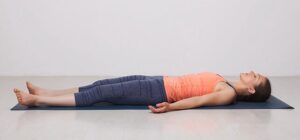

Lying meditation, also called supine meditation or “corpse pose” in yoga (Savasana), is a deceptively simple yet deeply effective practice where you lie flat on your back, usually on a mat or firm surface, with your body fully supported.
But it is much more than just resting. When practiced mindfully, lying meditation becomes a precise recalibration of your body’s alignment — especially for your neck and spine.
Here is how it works: you lie with your legs comfortably extended, arms relaxed at your sides, palms facing up, and the back of your head resting evenly on the ground.
Crucially, the neck is allowed to settle into a neutral, elongated position, free from the forward jutting posture so common with device use.
You consciously scan through the body, relaxing tension points, noticing asymmetries, and allowing the natural curves of your spine to reestablish.
This mindful stillness encourages the muscles that habitually overwork — like the upper trapezius and sternocleidomastoid — to let go, while the deep postural muscles can gently re-engage in their proper supportive roles.
Over time, lying meditation increases somatic awareness, helping you detect when you’re slipping into poor neck posture during daily activities.
Far from passive, it is an active reset that helps you reclaim healthier, more balanced alignment.
Here is What this Article Covers:
- Overview of Forward Neck Posture
- Benefits of Lying Meditation for Neck Posture
- Setting Up for Lying Meditation
- Incorporating Mindfulness Techniques
- Recommended Duration and Frequency
- Precautions and Considerations
- Complementary Practices
- FAQs on Lying Meditation for Neck Posture Correction
- A Strong and Convincing Conclusion
Overview of Forward Head Posture
Forward Head Posture (FHP) occurs when the head juts forward from the body’s centerline, placing extra stress on the cervical spine and surrounding muscles.
Studies have shown that for every inch the head moves forward, the weight on the cervical spine effectively doubles, leading to chronic tension, restricted movement, and even headaches.
This posture often develops from prolonged time at laptops, smartphones, or even improper sleeping positions.
Research from the journal Physical Therapy Science has emphasized that awareness and corrective strategies are key in reversing FHP before it becomes a long-term spinal issue.
Benefits of Lying Meditation for Fixing Poor Neck Posture
Lying meditation creates ideal conditions for the neck and spine to rest in true neutral alignment, something rarely achieved during daily activities.
When you sit or stand, gravity pulls your head slightly forward, often worsening forward head posture.
But when you lie flat on your back, especially on a firm surface, that gravitational strain is eliminated, allowing the head, neck, and spine to realign naturally.
Mindfully entering this position promotes deep muscle relaxation. The large muscles that normally brace the neck — like the upper trapezius and sternocleidomastoid — begin to release unnecessary tension.
According to research from the International Journal of Behavioral Medicine, mindfulness practices performed in lying positions significantly reduce muscle overactivation, particularly in the neck and shoulder regions.
With repeated practice, this relaxation and recalibration not only soothe current strain but also help retrain your neuromuscular system.
Over time, your neck becomes more capable of holding proper alignment throughout the day, reducing the risk of chronic pain and postural issues.
Setting Up for Lying Meditation
Proper setup is crucial for maximizing the benefits of lying meditation, especially when focusing on neck posture.
>>> First, surface matters: choose a firm, supportive surface like a yoga mat, carpet, or thin exercise mat. Soft beds or couches may feel cozy, but they let your body sink unevenly, compromising spinal alignment.
>>> Next, head support is key. Place a thin pillow or a neatly folded towel under the back of your head — not under the neck — to keep the head level and prevent it from tipping backward or forward.
>>> For leg position, it’s often helpful to bend your knees with feet flat on the floor. This takes pressure off the lower back and encourages the spine’s natural curves.
>>> Finally, arm placement matters: rest your arms alongside your body with palms facing upward. This gently opens the shoulders, balances the upper spine, and invites relaxation.
According to physiotherapy guidelines, such a setup minimizes compensatory spinal curves, allowing the cervical vertebrae to decompress naturally and supporting proper neck alignment.
Incorporating Mindfulness Techniques
Lying meditation is most powerful when combined with mindfulness, transforming it from passive rest into an active healing practice.
Begin by focusing on your breath — notice the gentle rise and fall of your chest or belly with each inhale and exhale.
Then, perform a slow body scan, directing your attention to sensations in your neck, shoulders, and jaw. With each exhale, gently invite any areas of tension to soften and release.
Neuroscience research on mindfulness meditation reveals that such focused attention decreases activity in brain regions associated with pain and tension perception, such as the anterior cingulate cortex and insula.
This results in both immediate physical relaxation and longer-term reductions in chronic tension.
Importantly, this mindful approach also helps interrupt unconscious habits, like clenching the jaw, tensing the neck, or shrugging the shoulders — patterns that silently reinforce poor neck alignment over time.
With regular practice, you retrain your nervous system to favor ease, balance, and proper posture.
Recommended Duration and Frequency
To see noticeable improvement in neck posture through lying meditation, a structured routine is key.
>>> Duration is your first building block: begin with 10 to 15 minutes per session. This gives your body enough time to settle and recalibrate without feeling overwhelmed. As you grow more accustomed to the practice, gradually extend sessions to 20 or even 30 minutes for deeper benefits.
>>> Frequency matters even more. Aim for daily practice, or at the very least, five times a week. This regularity is essential to retrain longstanding muscle patterns and cement healthier postural habits.
According to behavioral health research, it is consistency — not intensity — that drives the neuroplastic changes needed for lasting postural improvements.
In other words, you do not need marathon sessions; even short but regular daily practices can accumulate into meaningful structural and neurological changes over weeks and months, helping your neck find and maintain its natural alignment.
Precautions and Considerations
To achieve noticeable improvement in neck posture through lying meditation, following a structured and consistent routine is absolutely crucial.
>>> Start with duration: begin gently with 10 to 15 minutes per session. This allows your body and mind to gradually adapt, giving your muscles enough time to release tension and your nervous system space to recalibrate. As you become more familiar with the practice, you can slowly extend the duration to 20 or even 30 minutes, amplifying the postural and neurological benefits.
>>> Frequency plays an even more vital role. Daily practice is ideal, but if that’s not feasible, aim for at least five sessions per week. This regular engagement is what helps override old muscle memory and lock in healthier alignment patterns.
>>> Behavioral health research emphasizes that consistency, not intensity, is what drives neuroplastic changes — the brain’s ability to rewire itself. Over time, even modest, repeated lying meditation sessions build up, resulting in meaningful, lasting improvements in neck posture, muscle balance, and spinal alignment.
Complementary Practices
While lying meditation is powerful on its own, combining it with other supportive habits can accelerate results:
- Gentle Neck Exercises: Strengthen deep neck flexors and stretch tight chest muscles to support the posture improvements you make on the floor.
- Ergonomic Adjustments: Ensure that your office workstation is ergonomic and sleeping setup promote good neck alignment throughout the day and night.
- Movement Breaks: Get up every 30–60 minutes during desk work to reduce cumulative strain on the neck and shoulders.
A holistic approach, integrating lying meditation with these complementary practices, offers the best chance for long-term neck posture correction.
FAQs on Lying Meditation for Neck Posture Correction
Q-1: Why can lying meditation (supine) help a forward head more than sitting?
A-1: On your back, gravity stops pulling your head forward, so the overworked neck extensors can finally relax.
In a semi-supine setup (knees bent, feet on the floor), overall muscle tone drops and the nervous system settles. That “quiet background” makes it easier to let the head float balanced over the upper spine, instead of bracing. Think of it as a posture rehearsal without the load of standing.
Q-2: What breathing pattern should I use to unload my neck while I lie down?
A-2: Breathe slowly with the diaphragm. Let the lower ribs widen and the belly rise and fall—no lifting the chest or flaring the neck. When the diaphragm leads, the usual neck “helper” muscles (like the sternocleidomastoid and scalenes) don’t have to jump in, so your jaw and shoulders soften.
Aim for about 5–6 calm breaths per minute; if you feel the breath creeping into your neck, slow down and shorten the inhale slightly.
Q-3: How do I structure a 10-minute lying meditation that targets forward head posture?
A-3: Use the 3–3–3 + 1 routine:
Body scan (3 min): Notice the back of the head, shoulder blades, ribs, and pelvis touching the surface. Let the jaw unclench and the tongue rest on the palate.
Breath focus (3 min): Gentle diaphragmatic breathing with quiet shoulders.
Micro-nods (3 sets of 5 reps): Tiny “yes” nods on your exhale, as if moving only a few millimeters—no lifting the head. This wakes deep neck flexors without strain.
Stillness (1 min): Notice the sense of length from tailbone to crown.
Q-4: Will any of this carry over once I stand or sit at a desk?
A-4: Yes—if you add a transfer step. After the session, stand up and keep the same easy rib expansion while you gently “grow tall” through the crown. Begin your next task with one slow exhale, a tiny nod to align the skull over the neck, and relaxed shoulders. Repeat that 10-second reset every time you open a new email or app—small, frequent transfers beat one perfect session.
Q-5: What mistakes derail results—and how do I fix them?
A-5:
Pillow too high: It forces the chin down. Use a thin pad so your face points straight up.
Hunched shoulders: Support forearms on small towels to let them drop.
Neck breathing: Place a light book on your belly to cue the rise-and-fall there.
No progression: After a week, add 30–60 seconds of micro-nods; after two, practice the same breath and tiny nod during a seated break. Consistency plus gentle progression is what turns the practice into better posture.
Bottom line: Lying meditation removes load, resets breathing, and reintroduces subtle neck control.
Keep it small, calm, and repeatable—and let those quiet minutes reshape how your head sits over your spine the rest of the day.
Takeaway
Lying meditation is not just about relaxation — it is a targeted, evidence-backed method for improving neck posture and addressing the widespread issue of Forward Head Posture.
By thoughtfully aligning your body, calming your mind, and bringing conscious attention to muscular tension, you give your neck the conditions it needs to recover and realign naturally.
According to bestforwardheadposturefix.com, “Over time, consistent lying meditation retrains not just your muscles but also your nervous system, reshaping habitual patterns that lead to poor posture”.
Paired with mindful ergonomics and gentle exercises, this simple yet powerful practice can dramatically reduce neck discomfort, improve alignment, and even enhance your overall sense of well-being.
In today’s screen-filled world, where forward head posture has become almost the norm, lying meditation offers a cost-free, accessible, and scientifically supported solution.
Roll out a mat, lie down with intention, and take these moments each day to reset your body and mind. Your neck will thank you — and so will your posture, your comfort, and your long-term health.
References:

